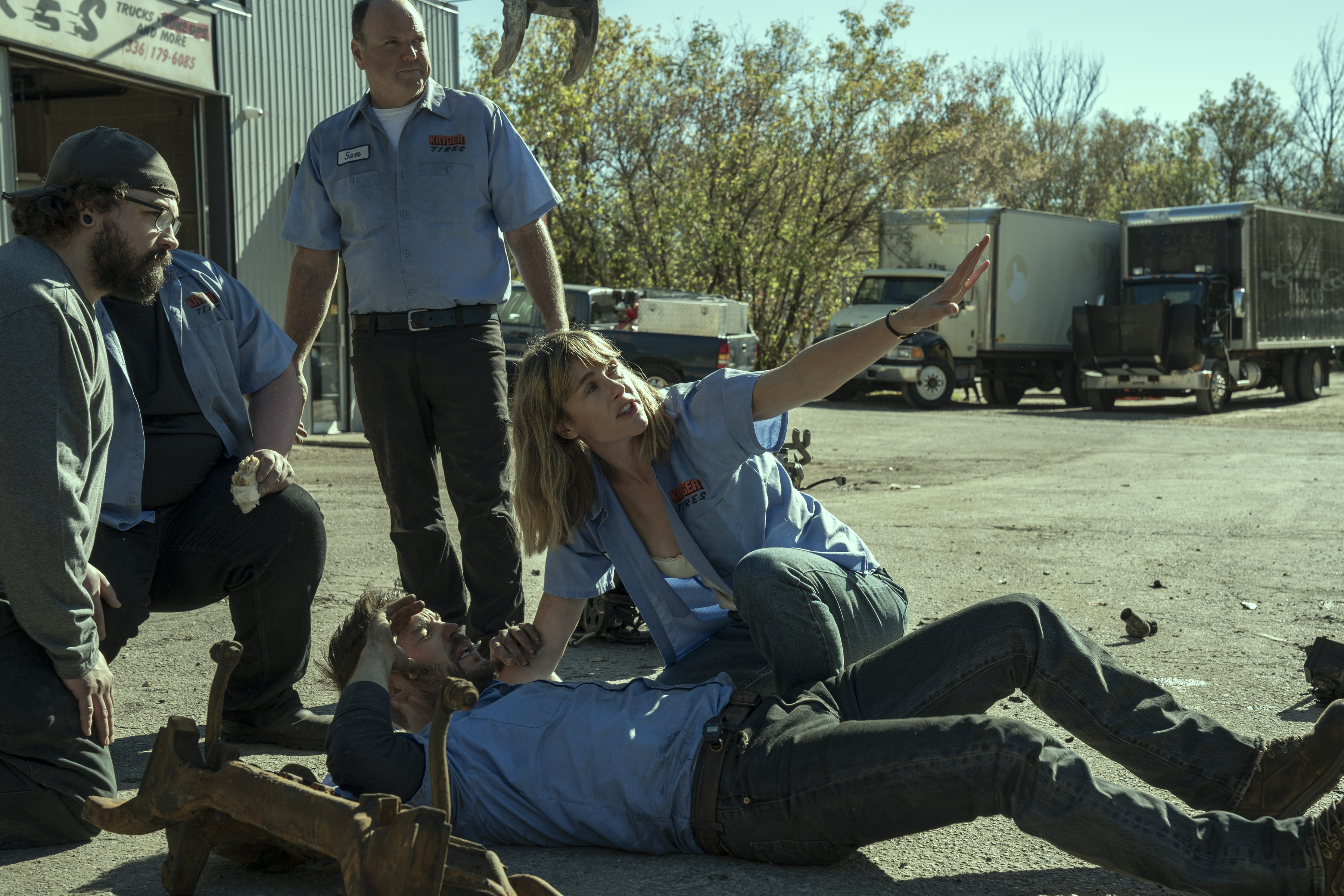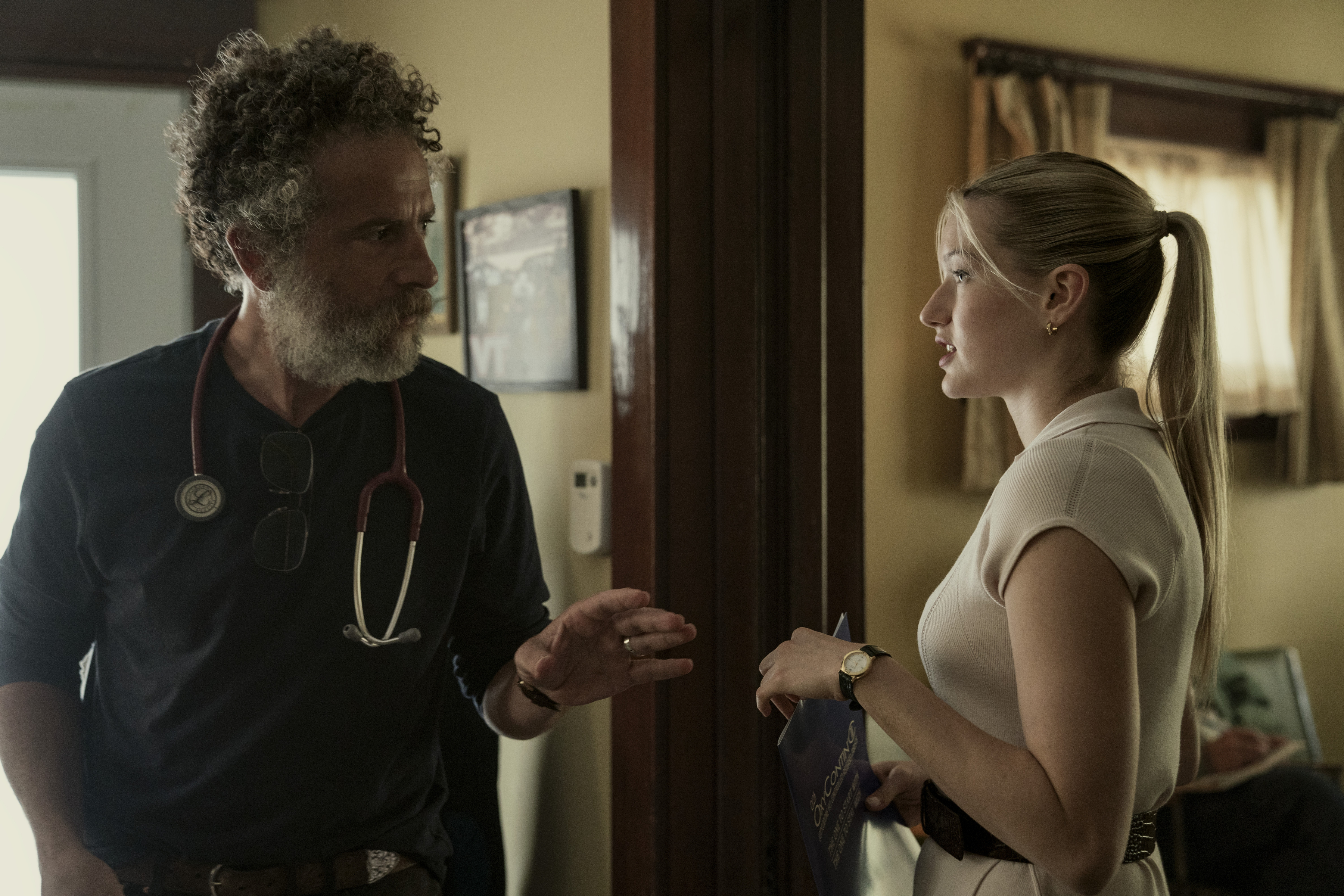
TL;DR
- Netflix limited series Painkiller was adapted from reporting on the opioid crisis and Purdue Pharma and the Sackler family’s role in creating it. The show combines facts with emotional truth to craft a compelling, intersectional narrative.
- The six-episodes were directed by Peter Berg, with Brendan Steacy, ASC, CSC, acting as DP for the emotionally fraught fictionalized series. Berg and Steacy worked to capture the actors’ rawest takes to be true to the feeling of the script and the story.
- The entire series was shot using handheld cameras and a limited number of lenses.
Netflix limited series Painkiller is a fictionalized adaptation combining two pieces of landmark coverage exposing the Sackler family’s role in America’s opioid crisis: Patrick Radden Keefe’s “The Family That Built the Empire of Pain” (2017) and Barry Meier’s Pain Killer (2003).
This six-episode take relies on the intersecting lives of both fictionalized composite characters (Uzo Aduba’s investigating attorney Edie Flowers, Taylor Kitch’s mechanic-cum-OxyContin user Glen Kryger, West Duchovny’s Purdue sales rep Shannon Schaeffer, among others) and portrayals of very real players, such as members of the Sackler family.
It is not the first television show to delve into this subject; it is far from likely to be the last. Friday Night Lights showrunner Peter Berg’s take relies on a strong cast and nimble crew to bring a unique offering.
“I felt more like a collaborative storyteller than a technical facilitator,” Brendan Steacy, ASC, CSC, told Lenspire, speaking about his time as Painkiller‘s cinematographer.
Steacy says director Pete Berg’s process is unusual. Berg ‟doesn’t want to commit absolutely to the ideas created in prep. He doesn’t like things to be structured.” In fact, Steacy compared the experience to working as a documentarian or performance artist because of Berg’s desire to ‟facilitate improv, lots of exploration” and, therefore, freedom of movement for the actors.
This was a new way of working for Steacy. ‟There’s not a lot of finessing or detailed lighting work,” says the DP, who also had stints as a gaffer. What the work did require, however, was a lot of handheld shots. A lot (read: entirely) and for long periods.
That meant Steacy had particular requirements for his camera and lenses. ‟We needed something that was fast because I really needed to be able to control where people were looking in frame. I needed something that offered super shallow focus. The lenses were one of the only tools we had left to us, and I needed to at least be able to control where someone’s eye goes and to make some of the background go out of focus.”
He selected the ARRI Alexa Mini LF and ZEISS Supreme Prime lenses.

Steacy worked with two main camera operators, Iain Barid and Brett Hurd, for the majority of the production, only adding a third full-time midway. Barid and Hurd were new to each other, but he says they developed a rapport that translated into ‟a sort of ballet” while shooting.
Before getting on set, Steacy had a plan for which would be best for the shoot. In true Berg spirit, that quickly went out the window. Steacy says, ‟I thought I was going to use the 40mm the most, along with the 65mm. The 50mm is kind of the messiest and tests the worst, but I ended up shooting almost the whole show on it. I fell in love with it. It renders faces absolutely beautifully. It has the most aberrations, which actually gives it the most organic feel.”
One moment when Steacy did swap lenses was quite dramatic. The main courtroom scene, seven pages long, was shot in a 25-minute take — but using three different lenses that were swapped as they were rolling!
‟If you watch the dailies, you can see the lens comes off and a new one goes on. We just kept going,” Steacy recalls.
READ MORE: Brendan Steacy ASC, CSC Pushes the Limit on Painkiller With ZEISS Supreme Primes (Lenspire)

Interview: Painkiller Colorist Joanne Rourke
Painkiller looks at the scourge of an under-regulated, over-prescribed narcotic from the perspective of Richard Sackler (Matthew Broderick) and many who suffered from the addiction it was supposed to have prevented.
The filmmakers brought the production to Company 3 in Toronto and Senior Colorist Joanne Rourke, with whom cinematographer Brendan Steacy had worked on the Silence of the Lambs spinoff series Clarice. Rourke, who does all her color grading in DaVinci Resolve, handled all six of Painkiller‘s episodes.
Finding the Best HDR Interpretation of the Imagery
Rourke started her work with the Dolby Vision grade and the agreed-upon plan to map the imagery to top out at 300 nits — a modest boost in the highlights over rec 709’s 100-nit cutoff, but without pushing the dynamic range beyond what the filmmakers felt was appropriate for the story.
As is common practice, Company 3’s image science team took the LUT that had been used transform the LOG dailies into rec 709 and mapped its properties to work in the HDR PQ space topping out at that 300-nit level. But as is often the case with HDR production, there were some surprises when Rourke and the filmmakers started screening the imagery in HDR.
It is still almost unheard-of for even high-end shows to be able to monitor in HDR during production, and it turned out that at 300 nits, certain information in the highlights proved hard to control.
“We were getting details, especially outside of windows, that Brendan never intended to appear in the show,” Rourke recalls. For example, when Shannon Schaefer (West Duchovny) visits a doctor to try to get him to prescribe OxyContin, and when Edie Flowers (Uzo Aduba) is in the boardroom narrating the story, “we were able to read detail in windows that were meant to be blown out.”
“We quickly pivoted to a LUT that contained the highlights to a maximum of 150 nits instead,” she says. “After that, everything fell into place. With that change, we met the requirements of the delivery specs and maintained the intended look.”
“Restraint” Was the Order of the Day
It was very important to Berg and Steacy that this show, about such an immediate, visceral situation, look real, without any sort of heavy look imposed in post.
“I had to exercise restraint,” Rourke says. “It became more about keeping the feel of the material and letting the pictures speak for themselves than adding looks.”
Within this requirement, there are several slightly different approaches to grading the imagery to subtly enhance the feeling of specific scenes. The result, she stresses, of “the sets, props and costume design, provided an atmosphere throughout. In the color, we never drove down too hard on black levels; there was a slight airiness, softness to it all. We did add some film grain throughout all the episodes, but it was a very small amount.”
For scenes set in pharmacies where the disastrous drug is dispensed, Rourke slightly brought out the cool, cyan look of the fluorescent-lit spaces. As a counterpoint, she notes, “Edie Flowers’ apartment is warm and moody, and we leaned into that in the grade.”
Meanwhile, portions reveal some of the backstory of the Arthur Sackler family from a time long before the main action of the show transpired, and for that, she used color to bring the imagery a “vintage feel — a specific warm feel, not a full color wash but it leans in that direction.”
Then, for moments where a character is going through OxyContin withdrawal, Rourke kept it moodier than the rest, pushing “more [picture information] into the shadows.” Steacy, she adds, referenced Nan Goldin’s provocative photography when discussing his intentions with these scenes.
“I often spend a lot of time on shows shaping and finessing,” she says, “but it really wasn’t necessary here. It was more important to remain organic for the look and feel of the story. Brendan’s images speak for themselves.”









